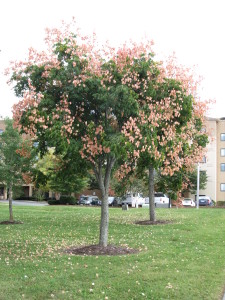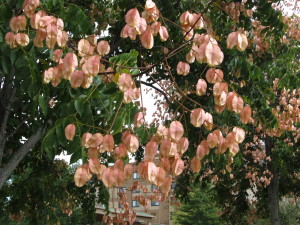Chinese flame tree, aka bougainvillea goldenrain tree (K. bipinnata), is another tree option in U.S. southern landscapes (USDA hardiness zones 7-10). It is closely related to the more widely planted goldenrain tree (Koelruteria paniculata). This fast growing tree develops into a nice 20-40 feet tall medium-size tree with an irregular canopy.
Chinese flame tree is highly drought tolerant (after one year established). It grows in average soil, and leaves holds up in urban air pollution. No serious disease or pests trouble the tree and deer leave it alone. Showy long panicles of fragrant yellow flowers appear in summer, one of a very few trees that do so. By mid-September attractive rose-colored seed capsules, mimicking bougainvillea flowers, have matured. They’re often added in dry flower arrangements.
Flame tree is easily distinguished from more popular Golden raintree (K. paniculata) since the former is more upright branched and has 2x pinnately compound leaves, compared to the single pinnate compound leaves of goldenrain tree Leaves hold late into autumn and turn a blah golden color before abscising. The bark on Chinese Flame tree is smooth and light brown when young, and becomes ridged and furrowed as it ages.
In deep South landscapes, flame tree is more multi-stemmed and reaches a height of 40 feet and higher as a specimen lawn tree. It is frequently seen planted in parking lots and highway plantings because of its landscape versatility.
Beware that seedlings from both Koelreuteria spp. will appear anywhere and everywhere in your landscape and all your neighbors’ yards. Pods and stems will fall over the winter. Flametree are for sale at on-line specialty nurseries



 Posted in
Posted in 
